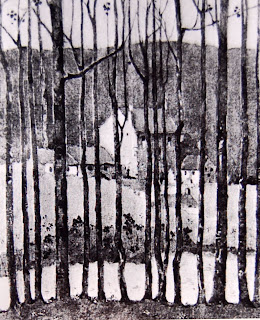Japonisme
In this short series of articles I have tried to show the impact Japanese art had on early masters of Modernism - Degas, Vincent Van Gogh and Toulouse Lautrec in particular.
If you are new to this blog and would like to read these earlier posts, then simply scroll down to find Parts 1, 2 and 3.
Part 4
This time I would like to look at landscape, yet from a surprising starting point
Kitagawa Utamaro
The outside walls of Japanese houses are often equipped with sliding grille walls known as shoji. The walls inside are defined by similar, lighter walls (fusuma). Indeed, the inner partitions of traditional Japanese houses are light wooden structures covered in paper through which the light shines.
19C Japanese Woodcut
Western artists, exposed to this work for the first time, quickly realised that the grille format pervaded Japanese art, resurfacing in surprising ways.
Bamboo - Tien-Sheng, Ch'ing dynasty
Western artists soon recognised the potential of this visual device and applied it to their own work, starting with copies of domestic scenes from the Japanese woodcuts and coloured prints to which they were increasingly exposed after 1858.
The railway - Edouard Manet (1874)
When this grille format was applied to landscape - as the Japanese masters themselves did - the results were liberating and opened up new ways for Western artists to depict trees, for example, within traditional landscapes:
The edge of the wood - E.H.Taylor (1912)
Japanese artists also showed the way in composition, freeing up French art still hamstrung by the strictures of Academic formalism. The woodcut below is by Ando Hiroshige, dated 1835. The semi-diagonal composition was characteristic of this genre of Japanese art and much copied by western artists.
The Japanese were also adept at finding the essential form of trees or plants, thereby creating a deceptively simple yet formulaic 'shape':
Mount Fuji - Katsushika Hokusai (c.1825)
The French quickly copied this device, creating their own 'bobble' trees on wobbly trunks!
Twilight (detail) - Henri Riviere
The painting shown below is by Maurice Denis and seems to combine not only the grille format but this peculiarly Japanese way of depicting 'bobble' or 'lolly-pop' trees - something surprisingly new in French art of this period.
The dance of Alcestis - Maurice Denis (1905)
The influence of Japanese art is also evident in two other great Modernists - Claude Monet and Gustave Klimt. The painting below is by Monet:
The four poplars - Claude Monet (1891)
Although Klimt is best known today for his elaborately decorated figure paintings (partly inspired by Japanese kimonos), he was a fine landscape artist - as this magnificent representation of a Silver Birch wood shows:
Gustav Klimt - 1902
If you would like to know more about this fascinating subject, then read Japonisme by Siegfried Wichmann, published by Thames and Hudson (1981) from whom I have taken the illustrations used in this short article.
Mike Healey
For other fine art books published by Thames and Hudson, click on the link below:











No comments:
Post a Comment